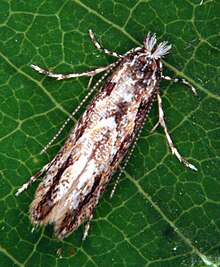Lithocolletinae
| Lithocolletinae | |
|---|---|
 |
|
| Phyllonorycter issikii | |
| Scientific classification | |
| Kingdom: | Animalia |
| Phylum: | Arthropoda |
| Class: | Insecta |
| Order: | Lepidoptera |
| Family: | Gracillariidae |
| Subfamily: |
Lithocolletinae Stainton, 1854 |
| Genera | |
|
10 |
|
10
Lithocolletinae is a subfamily of insects in the moth family Gracillariidae. It is distributed worldwide, with most species in temperate regions.
As of 2012, the subfamily contains over 540 species divided into ten genera. About half are native to the Palearctic ecozone, and over 100 occur in the Nearctic ecozone. About 66 species occur in the Afrotropic ecozone, 41 of which were described in the year 2012.
Moths of the subfamily are small, with wingspans under 10 millimeters. They are often colorful, with forewings in shades of orange or red-brown with white or silvery streaks, and a metallic, shiny ground color. Another trait sometimes used to distinguish species is the style of frass distribution. Species may leave their frass scattered about, deposited neatly along leaf veins or gathered at the feeding area, knit into a pile with silk threads, or spun into the cocoon.
These moths are associated with at least 870 species of host plants in 36 botanical families. Many feed on plants of the legume family, Fabaceae, and five genera are limited to them. Many species are monophagic, known from only one host plant. The larvae of most species are found on legumes, as well as the beech family (Fagaceae), the birch family (Betulaceae), the rose family (Rosaceae), and the willow family (Salicaceae).
Most larvae are leaf miners, which feed on leaves and produce distorting tissue damage. Most larvae suck sap during their first three instars, and consume the leaves during their final two instar stages. Familiar pests in the subfamily include Cameraria ohridella, which feeds on horse chestnut (Aesculus hippocastanum), Phyllonorycter blancardella, which feeds on apples (Malus spp.), Cremastobombycia lantanella, which attacks lantana (Lantana camara). Some larvae produce galls on plants.
...
Wikipedia
